Catfish are ray-finned, scaleless fish that add a lot of personality to the bottom of your tank. Different species have different pros and cons, but one of the most important aspects in choosing your catfish is finding the best tank size.
In general, the most ideal size tank for most species of catfish is 100+ gallons. That way, you can accommodate larger catfish like the common pleco and still have room for other schooling fish, semi-aggressive fish, and bottom dwellers.
100 gallons is the perfect tank size to accommodate the most popular species of freshwater catfish, but we understand that not every beginner aquarist is willing to dive right in at the deep end, so to speak.
Read on, because I’m going to break down the ideal tank size for catfish, both large and small. I’m also going to offer some personal advice on catfish species I would recommend for your tank based on temperament, care level, and size.

Table of Contents
Best Tank Size for Popular Species of Catfish

From the bristlenose pleco to the corydoras, there are a number of popular catfish species that you can put in your tank, even if you’re a beginner just starting out with a 10 or 20 gallon.
Here’s a helpful breakdown of some of the most popular species of catfish and the suitable tank size they need.
| Species | Recommended Tank Size | Max Fish Size |
| Bristlenose Pleco | 20 gallons | 5 inches |
| Corydoras Catfish | 10+ gallons | 4 inches |
| Otocinclus | 10 gallons | 2 inches |
| Bumblebee Catfish | 20 gallons | 3 inches |
| Clown Pleco | 20 gallons | 3-4 inches |
| Asian Stone Catfish | 10 gallons | 1.2 inches |
What Is the Perfect Tank Size for a Catfish?

Whether you want to include a lot of smaller catfish or 1-2 bigger catfish, a larger tank is always preferable to accommodate more fish. I personally recommend getting a tank of 100 gallons or more if you want to stock species like the Common Plecostomus or the Royal Plecostomus. Doing so gives you lots of space for your catfish, as well as freely allowing you to include smaller catfish.
Keep in mind that just because a catfish can thrive in a 10, 20, or 30 gallon minimum tank size doesn’t mean it’s ideal for them. The stocking and layout of the tank is important, too, so that the fish don’t feel crowded. Some species of catfish, for example, prefer to be around others of their kind, although they don’t school.
Bigger is always better if you want more variety, but, to summarize, your ‘perfect’ tank is one that accommodates all the fish you want to keep within your comfort and experience level.
Why Is Tank Size Important?
Tank size is significant to the well-being of your fish. A tank that is too small can negatively affect the water quality, stressing your fish out and reducing the visibility in the tank. It can also encourage territorial behavior, especially among catfish, who will be in conflict with other bottom dwellers for prime space.
Catfish prefer to have their own private space, and a larger tank keeps everyone happy by keeping the fish from having to interact if they don’t want to.
What Catfish Can Live in a 40 Gallon?
There are a number of catfish you can keep in a 40 gallon. Keep in mind, too, that having a 40 gallon tank gives you more leeway to include more catfish without running the risk of overstocking your tank.
1. Pictus Catfish
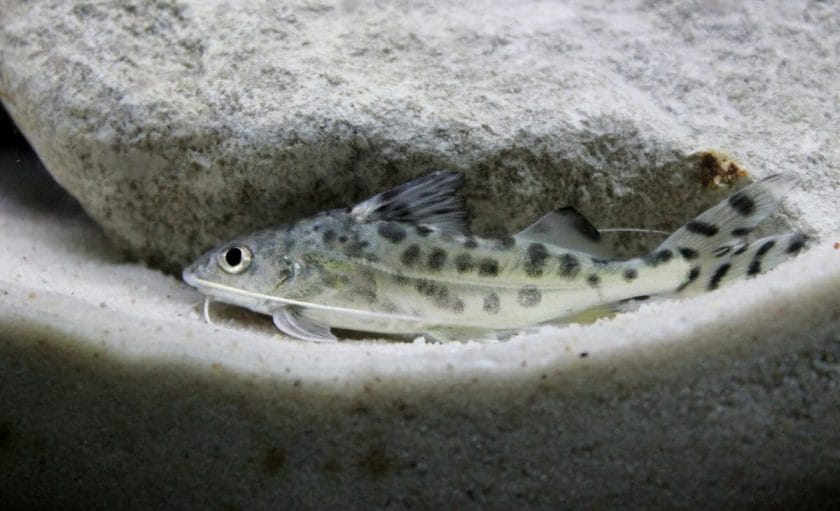
| Scientific Name | Pimelodus pictus |
| Max Size | 5 inches |
| Care Level | Moderate |
| Temperament | Semi-aggressive |
| Lifespan | 8-10 years |
| Temperature | 75-81 F |
| pH | 7.0-7.4 |
Pictus catfish are a great fish to include in a 40 gallon tank, although it’s preferable to keep them in a 50 gallon tank with a group of 6 or more. These fish have pretty strict care requirements and can be a little nippy, but it’s well worth it for their beautiful silver coloring and long whiskers.
2. African Butterfly Catfish
| Scientific Name | Pantodon buchholzi |
| Max Size | 5 inches |
| Care Level | Dependent on species |
| Temperament | Semi-aggressive |
| Lifespan | Up to 10 years |
| Temperature | 70-80 F |
| pH | 6.5-7.5 |
The African Butterfly Catfish is beautiful and a great, exotic addition to a larger tank. They should preferably be kept in groups. In fact, it’s recommended to have a 55 or larger tank if you’re housing them in large groups. Still, they’re versatile and mostly peaceful towards other species, making them a great pick for mid-sized tanks.
What Catfish Can Live in a 30 Gallon?
A 30 gallon tank is on the boundary between medium and small. As such, there are a few species of catfish that tread the line, needing something a little bigger than a 20 gallon to thrive.
Here are some of the species we recommend.
1. Bristlenose Pleco

| Scientific Name | Ancistrus cirrhosus |
| Max Size | 5 inches |
| Care Level | Easy |
| Temperament | Peaceful |
| Lifespan | 5 years or more |
| Temperature | 73-80 F |
| pH | 5.7-7.5 |
The bristlenose pleco is one of the best all-rounders for any tank size.
Most species of bristlenose plecos grow around 5-6 inches. They go wonderfully with most other fish, keep to themselves, and are hardy in a range of tank conditions.
If you’re interested in catfish but don’t want to dive in at the deep end, then the bristlenose pleco might be the perfect fish for you.
I’ve kept them for years with a variety of tankmates and never experienced any problems.
2. Glass Catfish
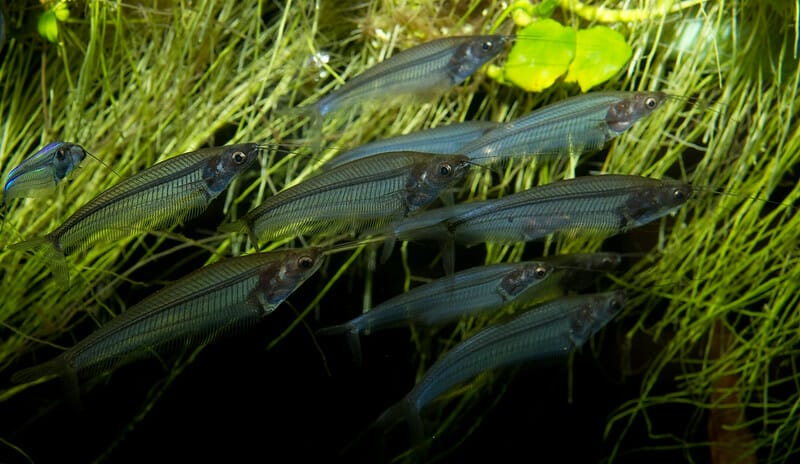
| Scientific Name | Kryptopterus vitreolus |
| Max Size | 5 inches |
| Care Level | Moderate |
| Temperament | Peaceful |
| Lifespan | 7-8 years |
| Temperature | 75-80 F |
| pH | Around 6.5 (slightly acidic) |
Glass catfish are unique fish that don’t adhere to the traditional catfish profile. They school and opt for a free-swimming lifestyle rather than being bottom dwellers. Glass catfish are extremely timid and sensitive to changes in temperature and pH, so be sure to account for these factors in your 30-gallon tank.
3. Upside-Down Catfish

Upside-down catfish. (2023, January 13). In Wikipedia.
| Scientific Name | Synodontis nigriventris |
| Max Size | 4 inches |
| Care Level | Easy |
| Temperament | Peaceful |
| Lifespan | Up to 15 years |
| Temperature | 72-82 F |
| pH | 6.0-7.5 |
Upside-down Catfish are resilient and happy in a range of tank conditions and pair well with tropical fish if you prefer. With beautiful coloration that proves to be quite eye-catching, the upside-down catfish is a great conversation starter.
What Catfish Can Live in a 20 Gallon?
Some species of catfish are smaller or can thrive in isolation, making them prime candidates for our 20-gallon list. Keep in mind that anything in a 20-gallon tank can also live (and might even prefer) a larger tank size.
1. Corydoras Catfish
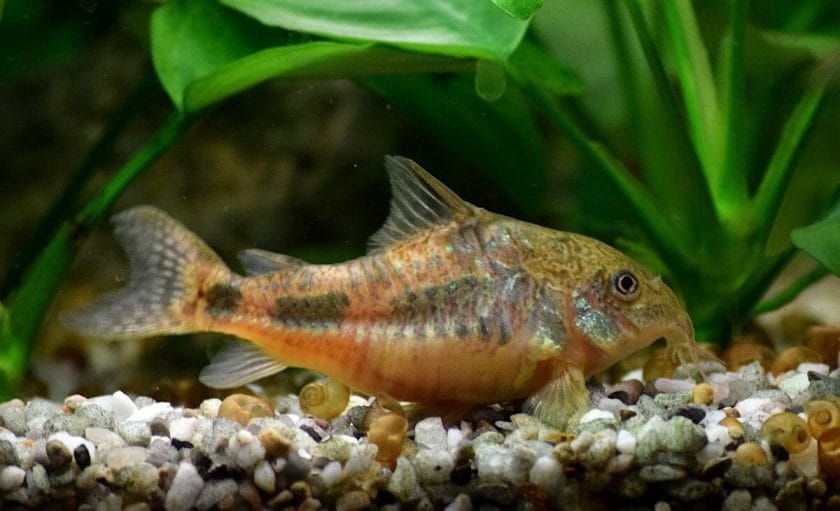
| Scientific Name | Corydoras paleatus |
| Max Size | 4 inches |
| Care Level | Easy |
| Temperament | Peaceful |
| Lifespan | 3-5 years |
| Temperature | 707-8 F |
| pH | 5.5-7.0 |
Cories are the perfect starter catfish for any size tank. They’re peaceful, hardy, and adorable. They come in a range of colors and species such as the too-cute panda cory. Cories have been a staple of my fish tanks for years; they’re just that adaptable to any tank type.
Keep them in a group of 6 or so for best results.
2. Clown Pleco

| Scientific Name | Panaqolus maccus |
| Max Size | 4 inches |
| Care Level | Easy |
| Temperament | Peaceful |
| Lifespan | 10-12 years |
| Temperature | 73-82 F |
| pH | 6.0-8.0 |
Clown plecos, too, are a staple catfish for smaller tanks. They’re striking in color, with ringed patterns across their bodies, and they love to rasp on wood. They are passive, independent, and hardy, making them great in smaller tanks.
3. Bumblebee Catfish

Bumblebee Catfish. CHUCAO, CC BY-SA 4.0
| Scientific Name | Microglanis iheringi |
| Max Size | 2 inches |
| Care Level | Easy |
| Temperament | Peaceful |
| Lifespan | 4-5 years |
| Temperature | 70-77 F |
| pH | 6.5-7.5 |
Small, hardy, and beautiful, bumblebees get their name from the black stripes that resemble–you guessed it–a bumblebee. They make a great first catfish for fishkeepers of any skill level, usually just minding their business at the bottom of the tank.
4. Otocinclus

| Scientific Name | Otocinclus |
| Max Size | 2 inches |
| Care Level | Easy |
| Temperament | Peaceful |
| Lifespan | 5-7 years |
| Temperature | 77-86 F |
| pH | 6.5-7.5 |
The otocinclus is a great fish with lots of personality. Known as a top-tier algae cleaner, this small fish is a great catfish for most fishkeepers.
They can be a little sensitive to changes in temperature or pH, and you’ll want to pair the peaceful otocinclus with other peaceful fish and provide them with plenty of places to hide.
Otocinclus prefer to be in groups of 6-10, necessitating at least a 20-gallon tank despite their individual small size.
Best Catfish for 100 Gallons or More
Some species of catfish (mostly just monster plecos) get really big and need appropriate accommodation.
1. Common Pleco

| Scientific Name | Hypostomus plecostomus |
| Max Size | Up to 2 feet |
| Care Level | Moderate |
| Temperament | Peaceful |
| Lifespan | 15-20 years |
| Temperature | 72-86 F |
| pH | 6.5-7.5 |
The common pleco, contrary to popular belief, gets really big and is a lifelong companion. Not only do they live a long time, but also they can get huge under the right conditions.
Accommodate these fish accordingly in a large tank to allow them space to grow, and be careful shopping at common fish stores; most owners won’t tell you that these plecos grow so big!
2. Sailfin Pleco
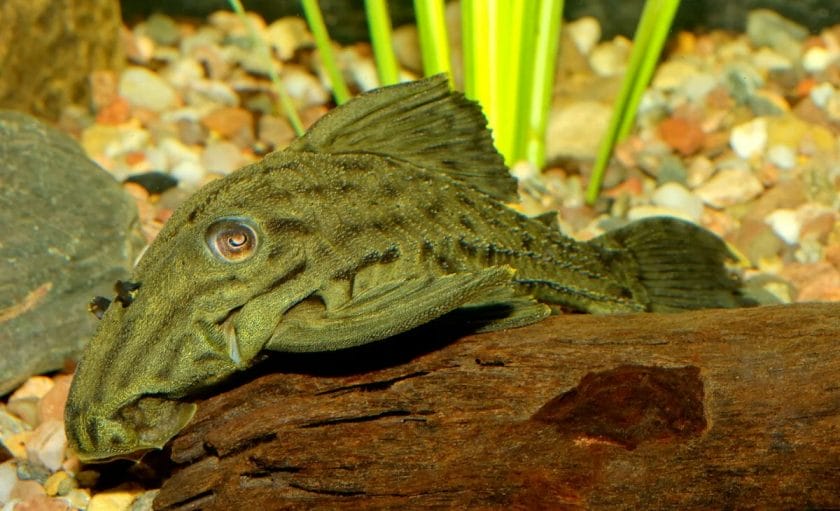
| Scientific Name | Pterygoplichthys gibbiceps, Glyptoperichthys gibbiceps |
| Max Size | Up to 18 inches |
| Care Level | Moderate |
| Temperament | Peaceful |
| Lifespan | 10-15 years |
| Temperature | 73-86 F |
| pH | 6.5-7.4 |
Sailfin plecos are another gentle giant that requires a larger tank size. Hardy and peaceful, they have striking black spots on top of a yellow undercoat. They’re gorgeous, but don’t be fooled. These behemoths get pretty big, up to 18 inches, and need at least 100 gallons to thrive.
3. Royal Pleco
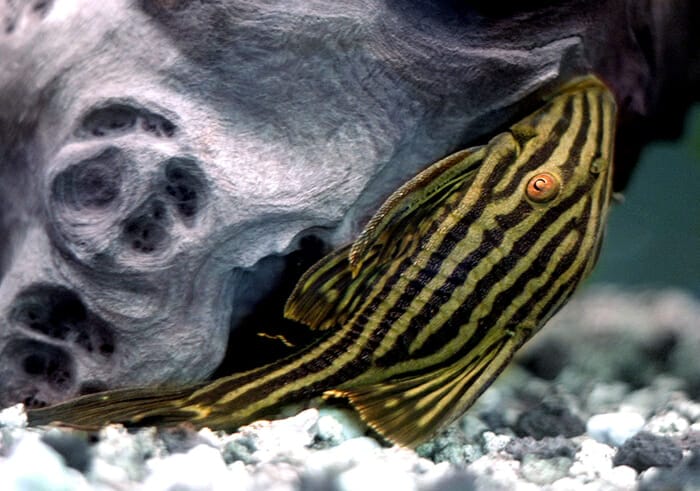
Panaque nigrolineatus. (2022, July 8). In Wikipedia.
| Scientific Name | nigrolineatus |
| Max Size | Up to 2 feet |
| Care Level | Moderate |
| Temperament | Peaceful |
| Lifespan | 10 years |
| Temperature | 73-86 F |
| pH | 6.6-7.5 |
The royal pleco is a large, distinct pleco that needs 120 gallons or more for best results. With light gray bodies, dark gray striations, and golden dorsal fins, royal plecos are extremely striking and make a great centerpiece in a tank.
4. Sunshine Pleco
| Scientific Name | Scobinancistrus aureatus |
| Max Size | 10-12 inches |
| Care Level | Moderate |
| Temperament | Peaceful |
| Lifespan | 8-10 years |
| Temperature | 77-84 F |
| pH | 5.8-7.2 |
The sunshine pleco is easily recognized by its yellow colorations and prominent dorsal fin. In fact, this pleco features yellow spots over its body and a golden color on its fins. They’re quite hardy as well, making them a great pick for larger tanks.
FAQs
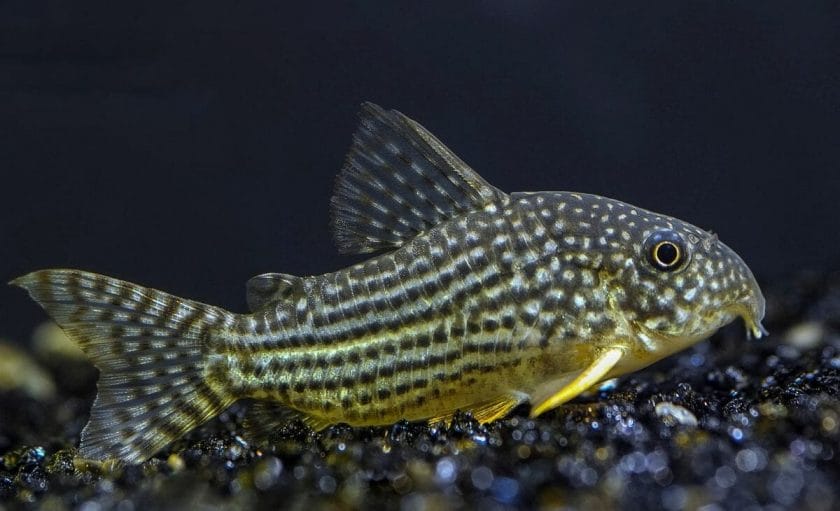
How Many Fish Can I Fit in My Tank?
A good rule of thumb is 1-2 gallons for every 1 inch of fish. Of course, some fish need to be kept in larger groups, and some fish produce more waste. The bacteria colony in your filter should be able to keep up with the waste production, resulting in zero ammonia and zero nitrites.
What Size Catfish Should I Get?
Choose a catfish that suits your tank size. Catfish under 5 inches are generally suited for 50 gallon tanks or below, while catfish closer to 10 inches require 100 gallons or more.
What Is the Best Catfish for Freshwater Aquariums?
The overall best catfish for beginners is the corydoras. These adorable catfish come in many different species, each with gorgeous color patterns. They’re peaceful, hardy, and the perfect tankmate.
Conclusion
Catfish is a great addition to a tank, but it’s important to do your research and make sure the species you pick up from the pet store is suited for your tank. It’s all too easy to pick up a tiny-looking fish without knowing, only to find out they turn into a 2-foot behemoth!
Be sure to use the helpful tables provided above to find the best catfish for your size tank!
If you have a small tank then I’ve already written an article showing the best catfish for small aquariums.